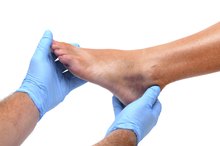Long-Term Effects of a Sprained Ankle
Ankle sprains are a common injury, particularly among people who play sports. According to a study published in March 2015 by the "World Journal of Orthopedics," approximately 2 million ankle sprains occur each year in the United States. This injury can lead to long-term effects, such as ongoing ankle pain, instability, weakness, stiffness and swelling. These side effects are more likely to occur when the initial injury is not treated appropriately.
If you are experiencing serious medical symptoms, seek emergency treatment immediately.
Persistent Pain
Persistent pain is the most common long-term effect of a sprained ankle. A September 2013 research review published in the "Journal of Orthopaedic and Sports Physical Therapy" indicated that up to one-third of people report pain lasting a year or longer after an ankle sprain 3. This pain might be related to additional injury that occurs with the ankle sprain, such as damage to tendons that hold muscles to the ankle bones. A sprain might also cause ankle damage that provokes breakdown of the padding between bones in the joint. Eventually the bones can rub against each other, causing arthritic pain. Pain might be managed with heat, ice or antiinflammatory drugs, such as ibuprofen (Advil, Motrin) or aspirin.
Joint Instability
What Are the Treatments for a Torn Ligament in the Ankle?
Learn More
Ligaments hold bones together, making a joint stable. Ankle sprains stretch ligaments, decreasing stability in the ankle. This might feel like the ankle will give out when you stand on it. According to the "Journal of Orthopaedic and Sports Physical Therapy" review, 20 percent of people reported joint instability as a long-term effect of ankle sprain 3. This instability can lead to spraining the ankle again 2. Treatment for ankle instability includes bracing and strengthening the muscles around the ankle. If conservative treatment is not successful, surgery might be required to repair the damaged ligaments.
- Ligaments hold bones together, making a joint stable.
- Treatment for ankle instability includes bracing and strengthening the muscles around the ankle.
Crepitus and Weakness
Crepitus is a grating sound or sensation that can occur with damaged ligaments. According to the "Journal of Orthopaedic and Sports Physical Therapy" review, 18 percent of people reported crepitus as a long-term effect of an ankle sprain 3. Crepitus might occur with all ankle movement or only when the ankle is swollen. Weakness, reported by 17 percent of people, also frequently remains after ankle sprain. Muscle or tendon damage that occurred with your ankle sprain can cause weakness. It can also develop when you are healing from the sprain and not able to use your ankle normally. Strengthening exercises are often performed to address this weakness.
- Crepitus is a grating sound or sensation that can occur with damaged ligaments.
Stiffness and Swelling
Elbow Hyperextended Treatment
Learn More
Stiffness affects 15 percent of people and swelling affects 14 percent of people long term after an ankle sprain, according the authors of the "Journal of Orthopeadic and Sports Physical Therapy" article 3. Swelling can lead to stiffness because it limits the mobility of the ankle. These symptoms can make it difficult to walk and maintain your balance. Swelling can sometimes be managed by elevating the leg or wrapping the ankle with an elastic bandage. Range-of-motion exercises to improve mobility of the ankle joint can reduce stiffness.
- Stiffness affects 15 percent of people and swelling affects 14 percent of people long term after an ankle sprain, according the authors of the "Journal of Orthopeadic and Sports Physical Therapy" article 3.
- Range-of-motion exercises to improve mobility of the ankle joint can reduce stiffness.
Precautions and Warnings
Ankle sprains that are treated early and correctly are less likely to cause long-term side effects. Seek medical treatment if you sprain your ankle -- even if you think the injury is minor. Seek treatment right away if you are unable to move your ankle or bear weight on your leg. This can be an indication of additional injury, such as a broken bone. If you've had an ankle sprain in the past and experience ongoing problems, see your doctor to determine the cause of your symptoms and appropriate treatment.
- Ankle sprains that are treated early and correctly are less likely to cause long-term side effects.
- Seek treatment right away if you are unable to move your ankle or bear weight on your leg.
Related Articles
References
- World Journal of Orthopedics: Management and Prevention of Acute and Chronic Lateral Ankle Instability in Athletic Patient Populations
- Journal of Athletic Training: Chronic Ankle Instability: Evolution of the Model
- Journal of Orthopaedic and Sports Physical Therapy: Ankle Stability and Movement Coordination Impairments: Ankle Ligament Sprains
- American Academy of Orthopaedic Surgeons. OrthoInfo. Achilles Tendinitis. Reviewed June 2010.
- American Academy of Orthopaedic Surgeons. OrthoInfo. Arthritis of the Foot and Ankle. Reviewed March 2015.
- American Academy of Orthopaedic Surgeons. OrthoInfo. Ankle Fractures (Broken Ankle). Reviewed March 2013.
- Arthritis Foundation. Arthritis and Diseases that Affect the Ankle.
- Robati S, Porter K, Shahid M, Crompton T, Sandiford N. Ankle osteomyelitis: an unusual presentation. JRSM Short Rep. 2013;4(6):35. doi:10.1177/2042533313476682.
- Merck Manual Consumer Version. Tarsal Tunnel Syndrome. Revised March 2018.
- U.S. National Library of Medicine. MedlinePlus. Common peroneal nerve dysfunction. Reviewed August 7, 2017.
- Mascard E, Gaspar N, Brugières L, Glorion C, Pannier S, Gomez-brouchet A. Malignant tumours of the foot and ankle. EFORT Open Rev. 2017;2(5):261-271. doi:10.1302/2058-5241.2.160078
- Tiemstra JD. Update on acute ankle sprains. Am Fam Physician. 2012;85(12):1170-6.
- American Academy of Orthopaedic Surgeons. OrthoInfo. Sprained Ankle. Reviewed February 2016.
- Arthritis Foundation. Lab Tests for Diagnosing Ankle Problems.
- Merck Manual. Professional Version. Cellulitis. Reviewed September 2019.
- American Academy of Orthopaedic Surgeons. OrthoInfo. Compartment Syndrome. Reviewed October 2009.
- American Academy of Orthopedic Surgeons. (n.d.). Arthritis of the Foot and Ankle.
- American Academy of Orthopedic Surgeons. (n.d.). Sprained Ankle.
- Koehler SM, Eiff P. (2018). Overview of Ankle Fractures in Adults. Asplund CA, ed. UpToDate. Waltham, MA: UpToDate Inc.
- Mascard E, Gaspar N, Brugieres L, Glorion C, Pannier S, Gomez-Brouchet A. Malignant tumours of the foot and ankle. EFORT Open Rev. 2017 May;2(5):261-71.
- Robati S, Porter K, Shabid M, Crompton T, Sandiford N. Ankle osteomyelitis: An unusual presentation. JRSM Short Rep. 2013 Jun;4(6):35.
Writer Bio
Aubrey Bailey has been writing health-related articles since 2009. Her articles have appeared in ADVANCE for Physical Therapy & Rehab Medicine. She holds a Bachelor of Science in physical therapy and Bachelor of Arts in psychology from the University at Buffalo, as well as a post-professional Doctor of Physical Therapy from Utica College. Dr. Bailey is also a certified hand therapist.









